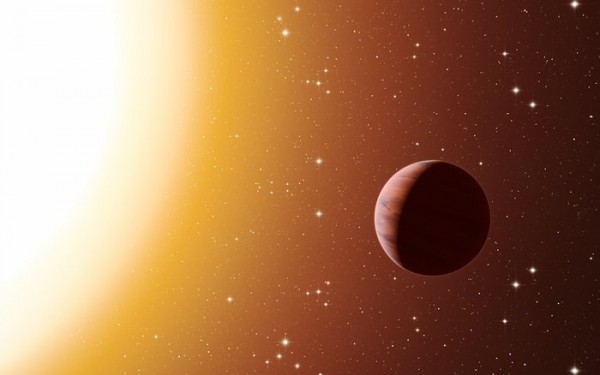More 'Hot Jupiters' Detected in Massive Star Cluster
| Ana Verayo | | Jun 19, 2016 06:58 AM EDT |
(Photo : ESO/L. Calçada) This artist’s impression shows a hot Jupiter planet orbiting close to one of the stars in the rich old star cluster Messier 67, in the constellation of Cancer (The Crab).
Astronomers have just discovered a massive cluster of "hot Jupiters" in a galaxy cluster known as Messier 67. Scientists consider these hot Jupiters as basically exoplanets with the size and mass of Jupiter but located in a much closer orbit to their host stars.
Like Us on Facebook
There are about 88 stars inside Messier 67 which are estimated to be the same age as the sun. Astronomers suggest that Messier 67 was created within the same conditions and environment as our solar system, as scientists have continued to study this cluster for the past seven years.
According to co-author of this study, Roberto Saglia from the Max Planck Institute for Extraterrestrial Physics, this open star cluster serves as a laboratory that can further explore the properties of exoplanets along with planet formation theories. He adds, these are not just many stars that can host possible exoplanets even Earth-like rocky planets but this is also considered as a very dense environment, where all of these star systems most likely formed.
To date, researchers have detected evidence of hot Jupiters inside three star systems among the 88 stars in Messier 67 which is equal to five percent. However, outside these star clusters, there is only less than one percent of hot Jupiters.
According to Anna Brucalassi from the European Southern Observatory's HARPS (High Accuracy Radial velocity Planet Searcher), which is a planet hunting telescope in Chile's La Still Observatory, this has been a really striking result.
Astronomers are suggesting that hot Jupiters most likely formed somewhere in their star systems but however, for some unknown reason, these exoplanets have migrated nearer their sun during their evolution.
Researchers theorize that stellar flybys could have thrown off hot Jupiters from their original orbits and pushed them closer to their host stars. For Messier 67, this cluster possesses a high density of stars, where it is possible that these stars' powerful gravitational forces could have affected each system more often than not.
This new study is published in the journal Astronomy & Astrophysics.
Tagshot jupiters, massive star cluster, messier 67, Exoplanets, jupiter like planets, ESO, jupiters
©2015 Chinatopix All rights reserved. Do not reproduce without permission
EDITOR'S PICKS
-

Did the Trump administration just announce plans for a trade war with ‘hostile’ China and Russia?
-

US Senate passes Taiwan travel bill slammed by China
-

As Yan Sihong’s family grieves, here are other Chinese students who went missing abroad. Some have never been found
-

Beijing blasts Western critics who ‘smear China’ with the term sharp power
-

China Envoy Seeks to Defuse Tensions With U.S. as a Trade War Brews
-

Singapore's Deputy PM Provides Bitcoin Vote of Confidence Amid China's Blanket Bans
-

China warns investors over risks in overseas virtual currency trading
-

Chinese government most trustworthy: survey
-

Kashima Antlers On Course For Back-To-Back Titles
MOST POPULAR
LATEST NEWS
Zhou Yongkang: China's Former Security Chief Sentenced to Life in Prison

China's former Chief of the Ministry of Public Security, Zhou Yongkang, has been given a life sentence after he was found guilty of abusing his office, bribery and deliberately ... Full Article
TRENDING STORY

China Pork Prices Expected to Stabilize As The Supplies Recover

Elephone P9000 Smartphone is now on Sale on Amazon India

There's a Big Chance Cliffhangers Won't Still Be Resolved When Grey's Anatomy Season 13 Returns

Supreme Court Ruled on Samsung vs Apple Dispute for Patent Infringement

Microsoft Surface Pro 5 Rumors and Release Date: What is the Latest?











